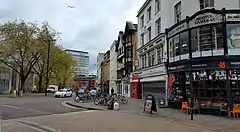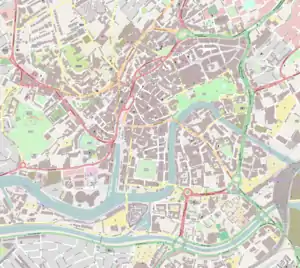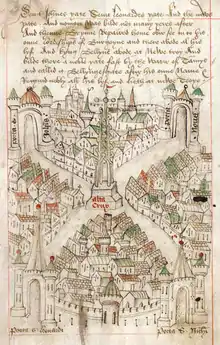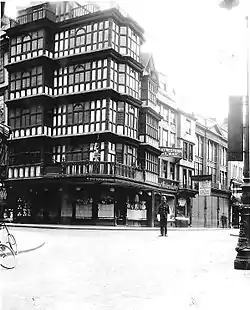 High Street, Bristol, looking from the central crossroads towards Bristol Bridge. | |
 Location within Central Bristol | |
| Maintained by | Bristol City Council |
|---|---|
| Location | Bristol, England |
| Postal code | BS1 |
| Coordinates | 51°27′16″N 2°35′33″W / 51.4545°N 2.5925°W |
| North | Broad Street |
| East | Wine Street |
| South | Bristol Bridge |
| West | Corn Street |
High Street, together with Wine Street, Broad Street and Corn Street, is one of the four cross streets which met at the carfax, later the site of the Bristol High Cross, the heart of Bristol, England when it was a walled medieval town. From this crossroads High Street runs downhill south-east to Bristol Bridge, a distance of approximately 155m.[1]
Once an important shopping street, wartime destruction and post-war planning have left High Street shabby and a constraint on pedestrian movement between the Old City and Castle Park. Bristol City Council are now seeking to redevelop the area to repair this.[2]
History

High Street, together with Corn Street, Broad Street and Wine Street, formed the earliest nucleus of Bristol.[1] It is shown clearly on Ricart's Plan, one of the first English town plans, with the High Cross at its top and St Nicholas Church (which then incorporated the town's southern gate) at its foot.[3]
The street appears to have changed little by the time Millerd's Citty of Bristoll map was published in 1673.[4] In 1747 the cleric John Wesley collided with a cart while passing through St Nicholas Gate on his way to a preaching engagement, and was shot over his horse's head 'as an arrow from a bow'. Neither man nor horse were hurt.[5] It was clear however that improvement was needed, and in 1760 a bill was passed through parliament primarily to replace Bristol Bridge, but also allowing for the removal of St Nicholas Gate and the rebuilding of the church. During these works the gradient of High Street was reduced.[5][6]
Puritan diarist Nehemiah Wallington describes Bristol Bridge and High Street in the 17th century as containing the chief shops of mercers, silkmen and linen drapers. Those who could not get premises on the bridge, which at that time was lined with shops, considered High Street the next best location.[5]
By the mid-19th century shop fronts lined the slope of High Street,[7] and development continued into the 20th century. Thomas Jones, the Pembrokeshire draper whose department store eventually became part of the Debenhams group, acquired three shops on High Street, ten on Wine Street and three on Mary le Port Street. In the 1920s the firm even tried to buy the landmark Dutch House which stood on the corner of High Street and Wine Street; when that bid failed the firm embarked on a modernisation programme which was almost complete by 1940.[8]
The majority of buildings on the east side of High Street were destroyed by aerial bombing on 24 November 1940.[9] St Nicholas Church, also damaged by bombing, was subsequently repaired and brought back into use.[10]
After the war, Bristol's shopping centre was moved to Broadmead.[11] In 1963 the few remaining buildings on the east side of High Street were demolished, the street was widened,[12] and its junction with Wine Street was turned into a short dual carriageway which diverted traffic away from the original crossroads with Corn Street and Broad Street.[13][14]
Post-war plans to build a riverside hotel and exhibition centre on High Street were quietly dropped on cost grounds, and new premises for the Bank of England and the Norwich Union Insurance Company were built in their place.[11]
High Street today
High Street forms part of the main north-south route through the Old City. Following its postwar widening, High Street and its junction with Wine Street constrain pedestrian movement between these streets and Castle Park.[12][2]
The east side of High Street 'has a lax, dissipated air, its former tension bled away on expanses of shabby paving'.[15] Bristol City Council is seeking redevelopment of this area, to help connect the markets area with the shopping quarter at Broadmead. This would include reducing High Street to more closely resemble its historic proportions.[16] The redevelopment of this area 'offer[s] perhaps the greatest potential of any site in the city to demonstrate the ambition of Bristol and to realise a connected and coherent historic core'.[2]
High Street is within the Old City and Queen Square Conservation Area.[17]
Sites of interest
- St Nicholas Church stands at the lower end of High Street near Bristol Bridge. Originally founded before 1154, the church was rebuilt in the 1760s and restored in the 1970s following bomb damage in the Bristol Blitz.[10]
- Opposite the end of St Nicholas Street two vaulted mediaeval cellars survive on the east side of the street, accessed through an unmarked doorway.[18][19]
- St Nicholas Market stands opposite the former junction of Mary le Port Street.[20][21]
Listed buildings
High Street has several listed buildings:
| Number | Grade | Year listed | Description |
|---|---|---|---|
| Scheduled Monument | n/a | Vault in High Street[18] | |
| II* | 1959 | City Museum, former church of St Nicholas[10] | |
| 31–34 | Unlisted building of merit | n/a | St Nicholas House[22] |
| II* | 1959 | The Market, High Street[20] | |
| 41 | II | 1977 | 41, High Street[23] |
| 42–43 | II | 1977 | 42 and 43, High Street [24] |
| 44 | II | 1977 | 44, High Street [25] |
| 45 | II | 1977 | 45, High Street [26] |
| 46a | II | 1977 | No 46a and attached rear area railings[27] |
| 47–48 | II | 1977 | 47 and 48, High Street[28] |
| 49 | II | 1977 | 49, High Street[29] |
High Street uses a clockwise-consecutive house numbering system, so No.1 was opposite No.49.[30]
Gallery
 The Dutch House in 1931.
The Dutch House in 1931. High Street, viewed from Bristol Bridge.
High Street, viewed from Bristol Bridge. Bristol's Front Door: High Street and Bristol Bridge, c1900
Bristol's Front Door: High Street and Bristol Bridge, c1900 Entrance to mediaeval vaults.
Entrance to mediaeval vaults. St Nicholas House.
St Nicholas House.
References
- 1 2 Watts, Lorna; Rahtz, Philip (1985). Mary-le-Port Bristol Excavations 1962/3. City of Bristol Museums and Art Gallery. pp. 16–17. ISBN 0-900199-26-1.
- 1 2 3 "The City Centre Framework - Old City - character statement and place plan" (PDF). Bristol City Council City Design Group. 2018. pp. 4–6. Archived (PDF) from the original on 28 May 2018. Retrieved 10 May 2018.
- ↑ "Plan of Bristol, from Ricart's calendar". Bristol Archives. Bristol City Council. Retrieved 10 May 2018.
- ↑ "Millerd's 'The Citty of Bristoll'". Bristol Museums Galleries Archives. Archived from the original on 30 April 2018. Retrieved 29 April 2018.
- 1 2 3 Wells, Charles (1969). "3 High Street and Vicinity". Bristol's History. Reece Winstone. ISBN 0 900814 29 2.
- ↑ Bantock, Anton (2004). Ashton Court. p. 29. ISBN 0-7524-3213-3.
- ↑ Winstone, Reece (1978). "Plate 13". Bristol in the 1850s. ISBN 0 900814 53 5.
- ↑ Reid, Helen (1987). "4 Oh Lord, send them in, send them in!". Bristol & Co. Redcliffe Press. ISBN 0 948265 61 2.
- ↑ Besley, James; Reid, Helen (1990). "2 Living Through the Blitz". West at War. Redcliffe Press Limited. ISBN 0 948 265 64 7.
- 1 2 3 Historic England. "City Museum, former church of St Nicholas (1202553)". National Heritage List for England. Retrieved 30 April 2018.
- 1 2 Priest, Gordon; Cobb, Pamela (1980). "Open Spaces". The Fight for Bristol. Bristol Civic Society and The Redcliffe Press.
- 1 2 Winstone, Reece (1978). "plate 107". Bristol as it Was 1960-1962. Reece Winstone. ISBN 0-900814-62-4.
- ↑ "Castle Park - west end". Bristol Civic Society. Archived from the original on 11 May 2018. Retrieved 10 May 2018.
- ↑ Winstone, John (1990). Bristol as it Was 1963-1975. p. 16. ISBN 0 900814 70 5.
- ↑ Foyle, Andrew (2004). Pevsner Architectural Guides: Bristol. Yale University Press. p. 139. ISBN 0 300 10442 1.
- ↑ "Bristol Central Area Plan" (PDF). Bristol City Council. 2015. pp. 60–61. Archived (PDF) from the original on 10 May 2018.
- ↑ "Conservation Area No.4 - City and Queen Square - Character Appraisal" (PDF). Bristol City Council. Archived (PDF) from the original on 4 May 2018. Retrieved 3 May 2018.
- 1 2 Historic England. "Vault in High Street (1004540)". National Heritage List for England. Retrieved 30 April 2018.
- ↑ "The medieval vaults you had no idea were behind this Bristol city centre door". Bristol Post. Archived from the original on 10 May 2018. Retrieved 10 May 2018.
- 1 2 Historic England. "The Market, High Street (1202292)". National Heritage List for England. Retrieved 30 April 2018.
- ↑ Winstone, Reece (1972). "Plate 9". Bristol as it Was 1914-1900. Reece Winstone. ISBN 0 900814 41 1.
- ↑ "Conservation Area No.4 – City and Queen Square – Character Appraisal". Bristol City Council. p. 33. Archived from the original on 2 May 2018. Retrieved 1 May 2018.
- ↑ Historic England. "41, High Street (1202290)". National Heritage List for England. Retrieved 30 April 2018.
- ↑ Historic England. "42 and 43, High Street (1293240)". National Heritage List for England. Retrieved 30 April 2018.
- ↑ Historic England. "44, High Street (1282262)". National Heritage List for England. Retrieved 30 April 2018.
- ↑ Historic England. "45, High Street (1208284)". National Heritage List for England. Retrieved 30 April 2018.
- ↑ Historic England. "No 46a and attached rear area railings (1208298)". National Heritage List for England. Retrieved 30 April 2018.
- ↑ Historic England. "47 and 48, High Street (1202291)". National Heritage List for England. Retrieved 30 April 2018.
- ↑ Historic England. "49, High Street (1208318)". National Heritage List for England. Retrieved 30 April 2018.
- ↑ "Search the List - Map Search". Historic England. Archived from the original on 21 March 2018. Retrieved 10 May 2018.